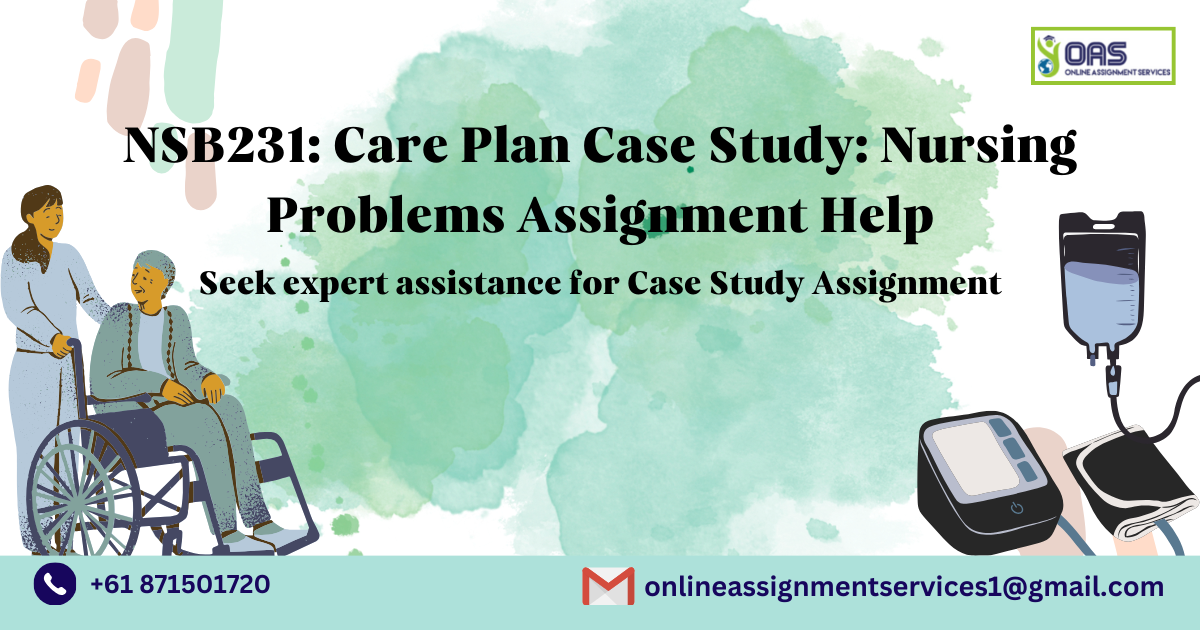NSB231: Care Plan Case Study: Nursing Problems Assignment Help

Question
NSB231: This nursing assignment of Queensland University of Technology requires the student to select a case study relating to a patient’s health issue. This assignment aims to analyze the given case study through the framework of evidence-based nursing practice and the cycle of clinical reasoning. The students are required to identify, discuss, and propose interventions, incorporating nurse-led and collaborative approaches. The interventions will be justified through a comparison with existing evidence-based practices, followed by a discussion on the evaluation criteria for assessing their efficacy.
Solution
The solution is written for the case study of a patient suffering from a chronic illness. The solution aims to apply evidence-based nursing practices and the clinical reasoning cycle to provide person-centered care for this case to enhance the patient’s outcomes through effective nursing interventions.
The case study revolves around a patient named Deborah with a history of familial heart disease and breast cancer, who faces mobility issues due to osteoarthritis. Her health concerns include weight gain, elevated blood glucose, high cholesterol, etc. Deborah’s lifestyle changes and medical needs require immediate attention for holistic management.
Our experts have organized the solution into different sections- an introduction is provided, followed by identification of the patient’s problems. The next section includes some nursing interventions which could be followed. The following section justifies the interventions chosen. Lastly, the methods for evaluating the effectiveness are proposed ending with a concluding paragraph.
The first section provides a brief introduction for the aim of writing this assignment as well as the case study.
Introduction
Chronic health problems involve condition that last for along time and worsen with time such as cancer, diabetes and heart disease among others. In a majority of countries, chronic health conditions are the leading cause of death, disabilities and illness among others which is evident in cases such as Australia that records more than 80% of deaths being linked to chronic conditions. Besides, they contribute to increased health burden in the society as well as hospitalization in order to manage the conditions and promote positive patient outcomes.
This is only half of the introduction. To know more, WhatsApp us at +447956859420.
The next section highlights how our experts have analyzed the case study to discuss two primary health issues directly impacting the patient’s well-being.
Patient Problem Identification
In this context, two key current problems directly impact the patient’s health which includes mobility problem influenced by painful osteoarthritis in her knees which has confined her in a wheel chair. The problem significantly affects her health and ability to engage in activities of daily living leading to negative outcomes and inability to effectively manage the chronic health condition. For example, she is unable to manage her diet due to the current mobility issue while her immune is affected by constant dependence on drugs. According to the case, the patient manages her arthritis knee pain through ibuprofen and paracetamol PRN. However, the condition further affects her chances of engaging in different activities such as CHRONIC HEALTH PROBLEM CASE 3cooking and baking as her favourite activities. According to the case, the patient has a has limited access to quality and reliable healthcare services owing to the idea that she lives in Queensland region about 400 km from a metropolitan hospital suggesting that receiving timely and effective care is challenging. Additionally, the patient has limited family support given that she only lives with her husband while her three children lives in Brisbane. The patients weight based on the health check is also high given that she has gained weight over time while her blood pressure is significantly also high which also increases the risks of negative health outcomes. Additionally, the patient’s periodic constipation and occasional gastroesophageal reflux has the potential of negatively affecting her recovery process as well as ability to engage in different activities. Besides, the mobility problem further enhances the reflux and constipation problem.
We have provided only one of the problems identified by our experts here. To get the complete solution, reach out today- onlineassignmentservices1@gmail.com.

The solution demands the student to review the case study and propose two interventions for each of the problems identified in the above section. Our experts have proposed interventions that are based on collaborative approaches, grounded in evidence-based practices.
Nursing Interventions
One of the key nursing interventions which can be adopted in addressing the first problem of patient mobility involves a physiotherapy procedure for the patient which is based on helping the patient manage her mobility problem after the knee is addressed. The physiotherapy procedure is based on the incorporation of specialty care and involvement of the patient in the care process to ensure the patient continually improve her mobility problem. Besides, the procedure is critical since it helps provide recommendations on the appropriate diets and medication which can help the patient continually regain her physical abilities. The combination of this procedure with osteoarthritis medication in her knees can help the patient in reducing the pain levels as well as regaining her mobility and ability to engage in her activities of daily living. According to the case, the patient is only on medications which helps in managing the pain as identified rather than treating the actual problem.
Want to read more about the chronic patient’s case and the interventions written by our experts? Call us today at +61871501720.
Our experts have supported the chosen interventions by comparing them with established evidence-based nursing strategies. You can read a snippet of this below.
Justification for the Interventions
The two nursing interventions identified involves combined medication for arthritis and physiotherapy care to respond to the patient’s mobility problem while the second nursing intervention involves collaborative partnerships that involves multidisciplinary teams. The justification for the nursing intervention on medication and physiotherapy is based on the idea that the patient has only been on pain based medication suggesting that the actual health problem have never been addressed. As such, provision of care or medication that focuses on the root cause of the pain can help in reducing the associated pain and mobility problem. Additionally, physiotherapy process is based on helping the patient regain her physical strength which is critical for her recovery. Implementing the intervention is based on involvement of a physiotherapist in a specialty care setting as well as medication to manage arthritis problem affecting her knees. Key consideration during the implementation of this nursing intervention involves the presence of specialty care in physiotherapy given that the patient lives miles away from the metropolitan hospital limiting the chances of receiving specialty care and overall positive outcomes. Special considerations will also be provided to the patient in regards to her preference on physiotherapy process as well as relocation to a specialty care setting.
Like the answer written by our experts? Read the complete case study assignment by reaching out to us via WhatsApp at +447700174710.
The following section of the solution points out the methods that can prove useful in the evaluation of the interventions.
Method of Evaluating the Interventions Effectiveness
The effectiveness of the interventions will be based on the overall patient outcomes such as the intervention on mobility. Assessing the patients pain levels prior to the intervention and after the intervention can help in understanding the effectiveness of the intervention. Reduced pain levels, improved mobility of the patient without the support of the wheel chair demonstrates critical improvements and effectiveness of the care process. Additionally, enhanced ability of the patient to engage in activities of daily living which was significantly hampered by her health condition can help in understanding the effectiveness levels. Other key data which can help in evaluating the effectiveness involves the ability of the patient to manage her emotions and stress levels. Improved ability of the patient to handle issues relating to her care such as medication and financial challenges as well as improved family involvement helps in demonstrating positive outcomes in the care process (Silva et al., 2017).
Still confused about how nursing interventions can be evaluated? We can help, just call us at +61871501720.
The last section includes a brief conclusion for the assignment. Our experts write articulated conclusions, a snippet of which you can read below.
Conclusion
According to the case selected, the patient is vulnerable to different health issues which has the potential of affecting her health outcomes. Key problems identified in the case involved mobility problem and psychological distress or stress problem which can all be linked to her health condition.
Do you also feel stuck with your case study-based assignments? Reach out at onlineassignmentservices1@gmail.com

